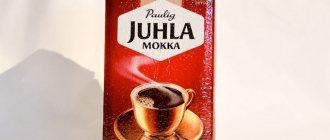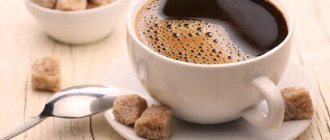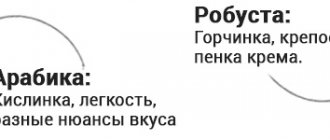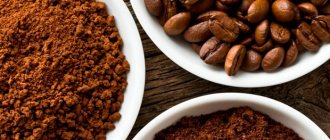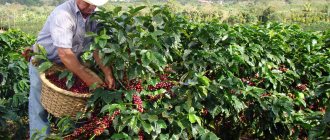Journey into history
French colonization brought more than just wars and misfortunes to Vietnam. Catholic missionaries, who appeared in large numbers in the early years of colonization, brought coffee beans here. The history of coffee in Vietnam dates back to 1857.
Coffee plantations in Vietnam
Very quickly, Vietnamese coffee enters the international market and by the middle of the 20th century it won second place in the world in terms of supply. With the outbreak of the war with the Americans, its production fell sharply and then began to rise again only in the 80s of the last century. Today, coffee plantations cover 503 thousand square meters. km of fertile land in mountainous areas, where up to 2.5 tons of grains are collected from 1 hectare.
Grain collection is carried out all year round. In 1996, Vietnam regained its honorable second place in the world coffee market; in 2001, it joined the International Coffee Organization, which forced the government to strengthen quality control of the exported product. In 2012, Vietnam moved up to 1st place, ahead of Brazil.
Today, almost all plantations are in private hands, the state share in the total volume is no more than 10%.
Characteristics
The main variety of Vietnamese coffee is Robusta, which means the drink is strong, rough, very rich, but without the complex bouquet of delicate Arabica notes. The Vietnamese balance some of the harshness of the taste with sweet condensed milk; classic “black coffee” is not very common here.
Condensed milk is the default ingredient in almost any Vietnamese coffee until stated otherwise.
Robusta contains 2-3 times more caffeine than Arabica (1.6-2.7% versus 1-1.5%), respectively, one small cup of real Vietnamese coffee is enough to wake up in the morning and stay alert until the evening.
Robusta is mainly grown in Vietnam.
Vietnamese coffee provinces
The first plantations were planted in the south, in Nghe An province in the late 80s of the 19th century. Later, Swiss microbiologist and researcher Alexandre Yersin discovered the ideal climate for coffee in the highlands around Da Lat, the capital of Lam Dong province.
Vietnamese collect coffee
By the beginning of the 20th century, coffee plantations occupied most of the Tay Nguyen plateau in Central Vietnam, which, in particular, included Lam Dong province. But the capital of coffee in Vietnam is considered to be the Dak Lak province, located there. In its center is the city of Buon Ma Thuot. There is a coffee exchange here.
Vietnamese coffee varieties
Vietnamese coffee is supplied to the market in beans (80% of them are green), ground and instant. The latter are represented not only by pure varieties - Robusta and Arabica, but also by blends.
Robusta
Initially, only robusta ─ Coffea Canephora was grown in Vietnam. This is the least demanding variety. It is characterized by high productivity at low costs. The Vietnamese Robusta variety compares favorably with its Asian and African counterparts in its mild taste and high quality. It lacks the sour note associated with beans grown in other regions.
Robusta coffee
Robusta varieties grown in Vietnam's mild climate are called Blue Dragon and Sang Tao. Blue Dragon is characterized by a light pistachio flavor with a hint of cocoa bitterness and a hint of fried bread. The Sang Tao variety demonstrates much greater strength and density of taste. Robusta is the strongest drink; it leaves other varieties far behind. 100 ml of coffee contains a medical dose of caffeine - from 1% to 2.5%. No wonder it is considered a “morning” drink among the Vietnamese.
Arabica
Arabica is not the most popular variety in Vietnam; it occupies no more than 10% of all plantations. This is a demanding plant, instantly responding to worsening climatic conditions with a decrease in yield. The main plantings of Arabica are located in Central Vietnam on the Tay Nguyen plateau. The varieties grown are “Catimore” and “Bourbon”.
Arabica coffee
The most popular variety among the Vietnamese and, in general, all lovers of local coffee is “Vietnam Dalat”. The taste of this drink has a slightly nutty hue with a refreshing berry note. You can almost never find Arabica in its pure form here; it is always mixed with Robusta.
Chon (luwak)
For some reason, when guides tell tourists about this coffee, they call it “luwak”, although this is not a Vietnamese name at all, but an Indonesian name. In Vietnam it is called Chon.
It is considered the most expensive in the world due to the way it is produced. The main player in the production chain is the palm marten - musang. The value of grains that pass through his digestive system lies in the fact that they are enriched with animal enzymes. The grain itself is not digested by the animal, only its soft shell.
Coffee Chon
At certain times of the year, coffee berries are introduced into the diet of musangs, replacing other foods with them. Then the excrement is washed and the clean beans are roasted. During the fermentation process, the grains are not only saturated with useful substances, but also acquire a softer, smoother taste.
Excel
You are unlikely to find it on sale in its pure form. This is a very rare variety that does not always produce a harvest. It is used in blending to soften the taste and give it a somewhat unusual aroma.
Moka
This variety has a low caffeine content and a light caramel flavor. It can be drunk at any time of the day, unlike Robusta. The taste lacks sourness and pronounced bitterness.
When roasting, coconut oil is added, which gives this variety an unusual taste. The basis for preparation is Arabica. We have identified it as a separate variety because it is one of the favorites among fans of Vietnamese coffee.
Coolie
This is high quality premium coffee. The grains for it are selected manually, which is why it costs a lot. Contains Robusta and Arabica. It is produced in small quantities and only in one place - in Dak Lak.
Coffee processing
Thanks to selected beans, Kuli has a very rich taste and quite high strength.
Blends
The Vietnamese mix varieties in proportions slightly different from traditional (European) ones. Typically blends contain 60% Robusta and 40% Arabica. There is a ratio of 70/30. This is why Vietnamese coffee is a strong drink.
In tourist places you can find blends with Luwak coffee on sale. Most often there is no smell of this expensive variety in the mixture. Under the guise of an elite variety, they may sell you a mixture of Robusta and Arabica.
Chon coffee added to the blend makes it very expensive. By the way, where real Chon is sold, it will never be called “luwak”.
"Signature" roasting
The smell and slightly chocolatey taste are the “trademark” of Vietnamese coffee. This is how it is fried only here. Once you try it or simply feel this magical aroma, you will never forget it and will not confuse it with anything else. Coffee beans are roasted with cocoa beans. The resourceful Vietnamese have many roasting methods, but this is the basic one. Chocolate flavor can be combined with caramel. This means that the grains were roasted with the addition of fruit syrups.
Coffee roasting in Vietnam
In Vietnam, coffee is produced not only for export, but also exclusively for domestic consumption. It is several times cheaper than what is sold in tourist shops. But that doesn't make it any less delicious. Many Russians living in blessed Vietnam prefer it.
Which coffee to choose and how much does it cost in Vietnam
You can buy already roasted beans in Vietnam in markets, coffee shops and supermarkets, as well as in souvenir shops and even pharmacies. However, it is worth considering that depending on the region and place of purchase, the quality, and most importantly the price of the product, can vary significantly.
Thus, the price of a package of ground coffee weighing 500 g in Nha Trang supermarkets is approximately 65 thousand dong. At the market or in a souvenir shop, exactly the same packaging can cost around 120 thousand VND.
The most expensive Chon Luwak coffee can be purchased only in specialized stores, at a price of 11 million VND per 500 g.
They sell mainly ground coffee or whole beans. It is almost impossible to buy instant or decaffeinated drinks here.
You can also purchase grains directly from the farmers themselves. In this case, the cost of a package weighing 500 g will be several times lower than the market price, but the quality of the product may leave much to be desired.
If you really want to buy grain from farmers. It is best to choose the Robusta variety. It is the most unpretentious and easy to grow, and does not require additional chemical treatment against insects.
Vietnamese coffee
There are several cooking methods – exactly the way the Vietnamese love it. The first is coffee with milk. Or rather, condensed milk with coffee. In Vietnam, it is customary to pour coffee into cups rather than cups. So, first, condensed milk is poured into it, and coffee is carefully poured on top. About the same amount as condensed milk, but very strong. Coffee and milk do not mix. The condensed milk should dissolve in it.
At your request, the seller can add ice there - up to the edge of the glass. It turns out to be the drink of the gods. At 6 o'clock in the morning you can see here and there small plastic tables where Vietnamese people are already sitting and enjoying their morning cup of coffee. Sellers prepare it in advance, pour it into bottles and put it in the refrigerator.
Vietnamese coffee
You can simply ask for “no sugar, no milk,” that is, without sugar and milk.
Do you want it hot, or do you want it with ice? You will not just be served a hot drink, but in a special “dropper”. This is a small metal mug with many holes in the bottom. Ground grains are poured into it, the whole thing is pressed with a press and poured with boiling water. While the drink seeps through the bottom of the “dropper”, it acquires a rich taste and strength. It is not customary to brew coffee in Vietnam. This is the only way to brew it. Almost everywhere they serve iced green Vietnamese tea with coffee. You can use it to dilute your coffee if it is too strong for you. The Vietnamese never drink their coffee to the bottom. There should be enough left in the glass for a couple of sips.
In the north, the Vietnamese love coffee with eggs. In Hanoi, it is served as follows: if you ordered hot coffee, they will bring you a glass in a bowl of hot water, and a separate cup with a raw egg, beaten until creamy. You can also order iced coffee, then it is served with ice.
Many people try to avoid drinks with ice in Asia. This, of course, is a personal matter for everyone, but so far none of the Russians or other foreigners have been poisoned by it or had stomach problems. And to be here and not drink iced coffee is a big omission.
Cooking process
In European countries, in most cases, a coffee pot or espresso machine is used to make coffee, which the Vietnamese do not do.
Residents of Vietnam have converted a French press into a special device that allows you to drip coffee through a filter into a vessel on which the device itself is installed.
2–3 tsp are preliminarily placed in the flask. Robusta coarsely ground, heavily roasted. 100 ml of boiling water is added, after which you need to wait a while to brew, and the liquid will soften the mixture, then pour into the vessel. If the container is empty, add a small amount of water.
If desired, add condensed milk: first pour it into the bottom of the glass, then pour boiling water over it.


